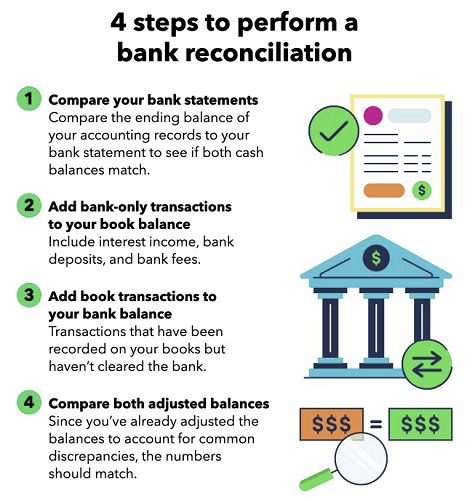Section 4-5: Reconciling the Bank Statement
Section 4-5: Reconciling the Bank Statement
Overview

 Reconciling your bank statement is the process of comparing the transactions listed on your bank statement with your own records to ensure they match. This helps you identify any discrepancies, errors, or unauthorized transactions. Here's a step-by-step guide on how to reconcile your bank statement:
Reconciling your bank statement is the process of comparing the transactions listed on your bank statement with your own records to ensure they match. This helps you identify any discrepancies, errors, or unauthorized transactions. Here's a step-by-step guide on how to reconcile your bank statement:
Gather Documents: Collect your bank statement for the period you want to reconcile, as well as your check register or transaction records where you have recorded your own deposits, withdrawals, and other transactions.
Check Deposits: Compare the deposits listed on your bank statement with those recorded in your check register or transaction records. Make sure all deposits are accounted for and that the amounts match.
Check Withdrawals and Payments: Similarly, compare the withdrawals and payments listed on your bank statement with those recorded in your check register or transaction records. Pay special attention to checks that have cleared, electronic payments, debit card transactions, ATM withdrawals, and any fees or charges assessed by the bank.
Tick Off Matches: As you go through each transaction, tick off or mark those that match between your records and the bank statement. This helps you keep track of which transactions you've already reconciled.
Identify Discrepancies: If you notice any discrepancies between your records and the bank statement, investigate them further. Common discrepancies include missing transactions, errors in recording transactions, or unauthorized charges. Double-check your records, look for any outstanding checks that may not have cleared yet, and verify the accuracy of each transaction.
Adjust for Outstanding Items: If there are any outstanding checks or deposits that have not yet cleared the bank, make note of them and adjust your records accordingly. For example, subtract the amount of outstanding checks from your bank balance to get a more accurate picture of your available funds.
Calculate the Reconciliation: Once you've identified and resolved any discrepancies, calculate the reconciliation by comparing your adjusted bank balance with your adjusted book balance. Ideally, these two balances should match. If they don't, double-check your calculations and review your records again to find any errors.
Record Reconciliation: Record the reconciliation in your check register or transaction records. Note any adjustments made and the final reconciled balances for both the bank and your records.
Document the Process: Keep a copy of your reconciled bank statement, along with any supporting documentation, for your records. This serves as proof of your reconciliation efforts and can be helpful for reference in the future.
Repeat Regularly: Reconciling your bank statement should be done regularly, ideally every month when you receive your statement. This helps you stay on top of your finances, detect any issues early on, and ensure the accuracy of your records.
By following these steps and reconciling your bank statement regularly, you can maintain accurate financial records, identify any discrepancies or errors promptly, and have better control over your finances.
Videos (Click on Image to View Videos)
Online Textbook Read Section 4-5: (Reconciling the Bank Statement)
